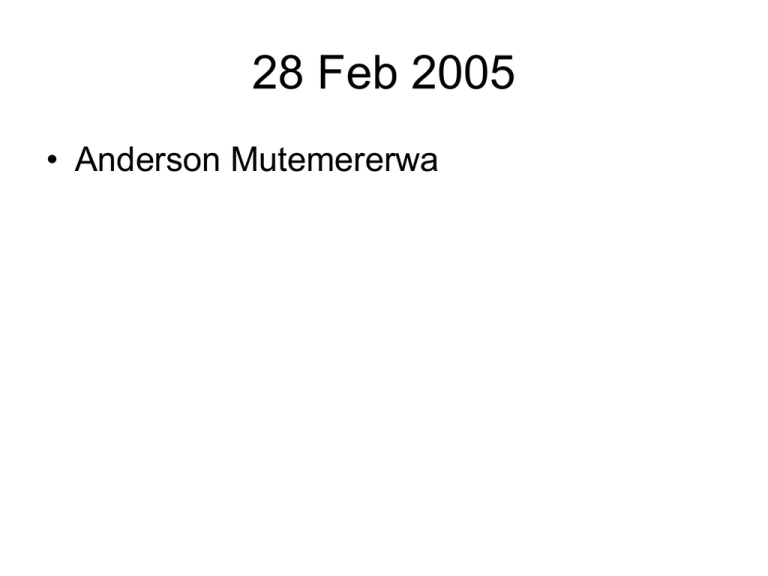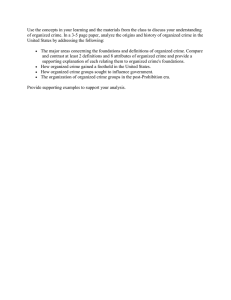Crime & Criminal Law - The Economics Network
advertisement

28 Feb 2005 • Anderson Mutemererwa Crime & Criminal Law Empirical Studies Modelling The Cost of Crime • • A.K. Lynch, T. Clear & D. Rasmussen Suggested 3 Approaches to Estimating Cost of Crime – 1. Asking victims to quantify and estimate the costs they suffer such as the value of stolen property, medical costs incurred, forgone productivity as a results of victimisation. Likely to understate the cost of crime (value of non-monetary psychological costs such as pain and suffering). – 2. Establish an empirical relationship between costs of crime and magnitude of jury awards in similar cases. Juries tend to award compensation that, in the juries’ view, make the victim whole again. This approach gives a more complete accounting of costs than the survey method and tends to take care of the short and long term productivity losses and pain and suffering. – The second approach assumes that the relationship between direct costs and pain and suffering costs is the same for all victims– a biased sample of cases that go to trial where the plaintiffs and the defendants likely disagree about appropriate settlements. – Further are the estimates of costs plausible? Enormous pain and suffering estimates contributes to the vast costs crimes in work done by Cohen, Miller and Weirsema (1995). – 3. Base the estimate of crime cost on the relationship between crime levels and property values. Hence people are willing to pay a premium to stay in a neighbourhood where crimes levels are low. Hence differences in property prices, ceteris paribus, will capture the willingness to pay for a lower probability of being a victim of crime. Hence an implicit price of spatial variations in crime can be captured by implicit price models of housing markets. – This method of using implicit prices is appealing as it tends to reflect the extent to which people are willing to “vote with their feet” to get increased public safety. – The theory behind this approach is quite established. Goods with many attributes such as houses or cars can be decomposed into a bundle of underlying characteristics each of which has an implicit price. The selling price of a house is determined by such things as age, number of rooms, lot description (waterfront, size etc.), neighbourhood attributes (poverty rates etc.) and the levels and seriousness of crime in that area. Changes in any of these will affect the dwelling's selling price. – Implicit prices (hedonic) models are used to determine how changes in any of the abovementioned underlying attributes affect the market prices for homes. – Most of the studies show that crime lowered house prices. A study by Thaler (1978) in Rochester, N.Y found that average property crime lowered $1930. Helman and Naroff (1979) and Rizzo (1979) used census prices from Boston and Chicago respectively and found estimate that a 1 per cent rise in the overall crime rate lowers house prices by 0.63 per cent. – Cohen (1990) however, claims that these studies are biased as they rely on reported crime rather than the cost of crime (hence a burglary is treated the same as larceny while unarmed robbery is treated the same as murder). Seriousness of crime was thus ignored – Lynch and Rasmussen (1998) explore Cohen’s hypothesis and find that the number of property crimes has a positive impact on house values in a hedonic model while an alternative cost of crime model has a significantly negative effect on house values. Estimating the Costs of Crime • Used a hedonic model. • Data come from the proportion of singlefamily dwellings sold in Jacksonville (FL) between 1 July 1994 and 30 June 1995. • The selling price of a house in regressed on house and lot characteristics, neighbourhood characteristics, and crime occurring in the area. • Pi = f(Si,Ni,Ck) – where Pi is selling price of house – Si is vector of structural and lot characteristics – Ni is a vector of neighbourhood characteristics – Ck is the estimated cost of crime in the relevant police beat area. • Jacksonville, FL has population of 712 000. Intercept Weighted Crime High Crime index hedonic area-interaction model coefficient estimates 10.59* Weighted Crime High Crime areaindex hedonic interaction model estimates coefficient Propertyspecific Variables Square footage 0.0005* 0.00001566 Lot size 0.0335* 0.1695 Bedrooms -0.0238*** 0.0107 Log (age of homes) -0.0643* 0.0211 Weighted Crime index hedonic model estimates High Crime areainteraction coefficient 0.0542 0.0174 Covered Parking 0.0920 Spaces Fenced Property 0.0137 0.0109 Propertyspecific Variables Pool 0.0703 Weighted Crime High Crime index hedonic area-interaction model coefficient estimates Propertyspecific Variables Fireplace 0.618 Central heating 0.1245 Central Air 0.1192 conditioning Vacant -0.0912 -0.0095 0.0241 -0.0333 0.0533 Weighted Crime High Crime index hedonic area-interaction model coefficient estimates Propertyspecific Variables Assumable mortgage Waterfront Property Gated Community 0.0136 0.0209 0.1542 0.0104 0.1690 -0.1486 Weighted High Crime Crime index area-interaction hedonic model coefficient estimates Neighbourhood Variables Population -0.0001197 0.000008497 Percentage white 0.2957 -0.0979 Percentage Hispanic Percentage 3.6638 0.6278 0.4786 2.0079 Weighted Crime High Crime areaindex hedonic interaction model coefficient estimates Neighbourhood Variables Percentage bachelors degree Percentage owneroccupied Percentage kids (under 17) Percentage young adult (18-24) 0.0791 -1.0494 -0.1064 0.4255 -1.3653 2.2850 -1.0836 2.9819 Weighted Crime High Crime areaindex hedonic interaction model estimates coefficient Neighbourhood Variables Percentage older -0.0527 (over 55) Median household 0.000003908 income Median-average -0.156158E-12 Income Population Growth -0.3941 (1990-96) 2.7457 0.000002 2.003E10 0.3276 Weighted Crime High Crime index hedonic area-interaction model coefficient estimates Crime Variables Log (cost of -0.0163 violent crimes in $) Log (cost of -0.0289 property crimes in $) High crime area -3.0699 Discussion of Results • Older homes and those that are vacant at the time of sale are sold at a discount • The lower the number of bedrooms (for a given square footage) the higher the price of the property (larger bedrooms) • Population with one mile of an observation is an implicit measure of population density and has a negative impact on sales. Other factors that reduce sales price of dwellings are number of kids under 18, a measure of income dispersion (the square of the difference between median average income). Discussion of Results • The sales price of houses is higher, ceteris paribus, in neighbourhoods with more whites than Hispanic residents and higher in those with white collar residents. • The column on high-crime interaction basically shows the interaction of each of the characteristics in the middle with high crime. This column shows the amount by which each coefficient rises in high crime areas. Discussion of Results • The cost of crime coefficients have the expected negative signs, with cost of violent crime being significant at the 10 per cent level of significance. They however, are modest in magnitude. • Property crime is very significant at the 1 per cent level of significance. • Most striking is that the coefficients reveal a very modest impact on sales. Hence a 10 per cent decrease in the cost of property crime raises the price of a home by $275 and a similar decrease in violent crime increases expected sales prices by $155 (probably because victims tend to know the offenders in the USA). Discussion of Results • Four neighbourhood characteristics of high crime area: percentage white collar, percentage over 55, percentage owneroccupied and the measure of income dispersion are statistically significant with the excepted signs. Population stability seems to be important in successful neighbourhoods, a factor fostered by homeowners, older households and is therefore associated with higher sales prices. Conclusions • The study shows that the cost of crime seems to have a trivial effect on the price of an average house in Jacksonville, FL. • The average homeowner’s implicit price for a 10 per cent decline in crime is $15, markedly different from the actual cost of crime. • Total cost of crime per capita in Jacksonville, FL is about $933 per year. • Conclusions • Two factors probably account for the differences between implicit prices and costs of crime. – (a) probability of being victimised is less than 1 and affected by the behaviour of the household (private investment in protection, diligence etc.) – (b) the option of zero risk is not available and the implicit price estimate is based on differences in public safety which can be achieved within the relatively safe areas which are characteristic of most housing markets. Conclusions • Final conclusions – Weighting crimes by their seriousness significantly improves models of the cost of crime via implicit price models. – Although, cost of crime using estimated from jury awards may be criticised, in implicit models they appear superior to alternative measures of crime which do not weigh crime by its seriousness.







